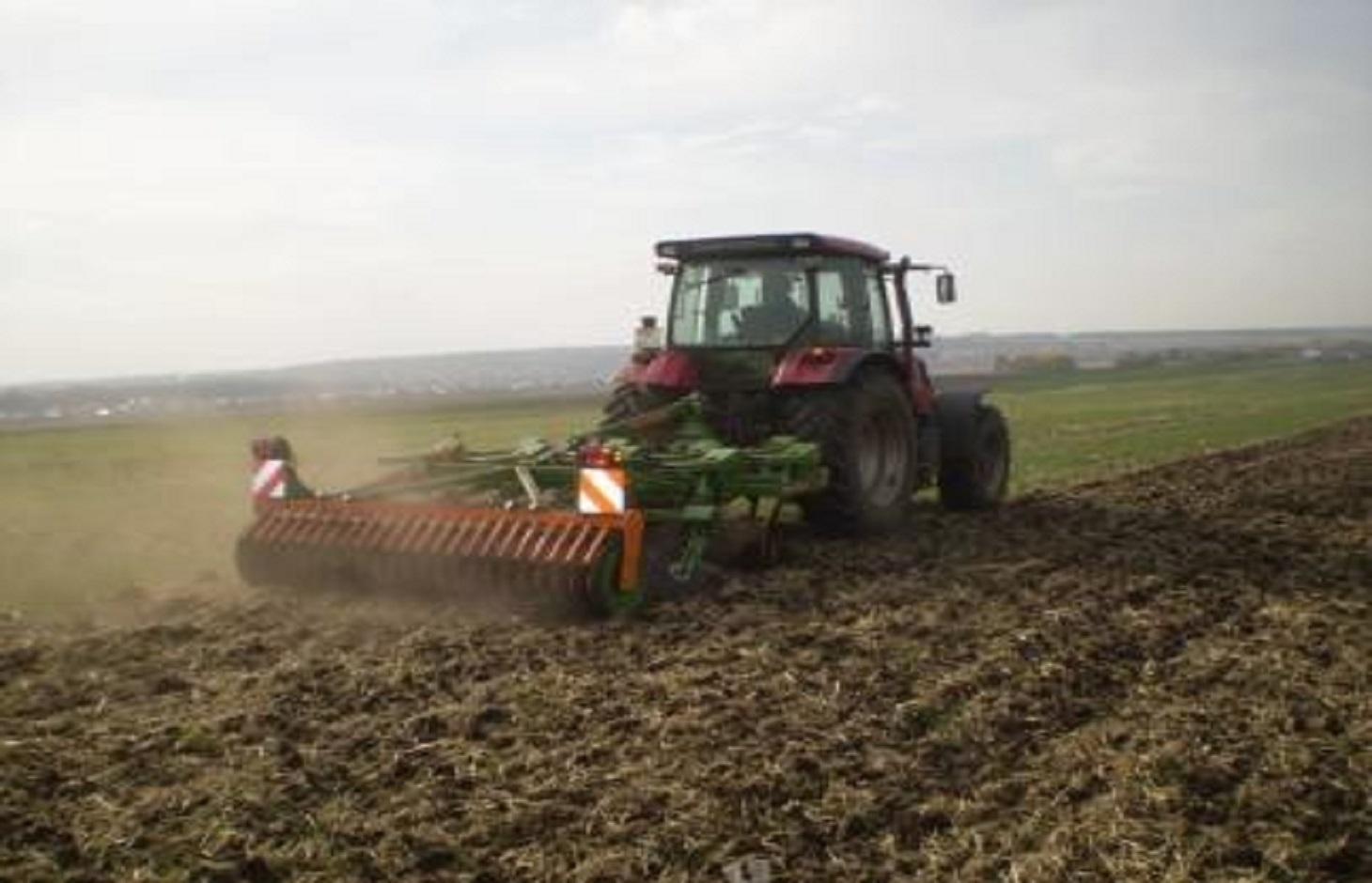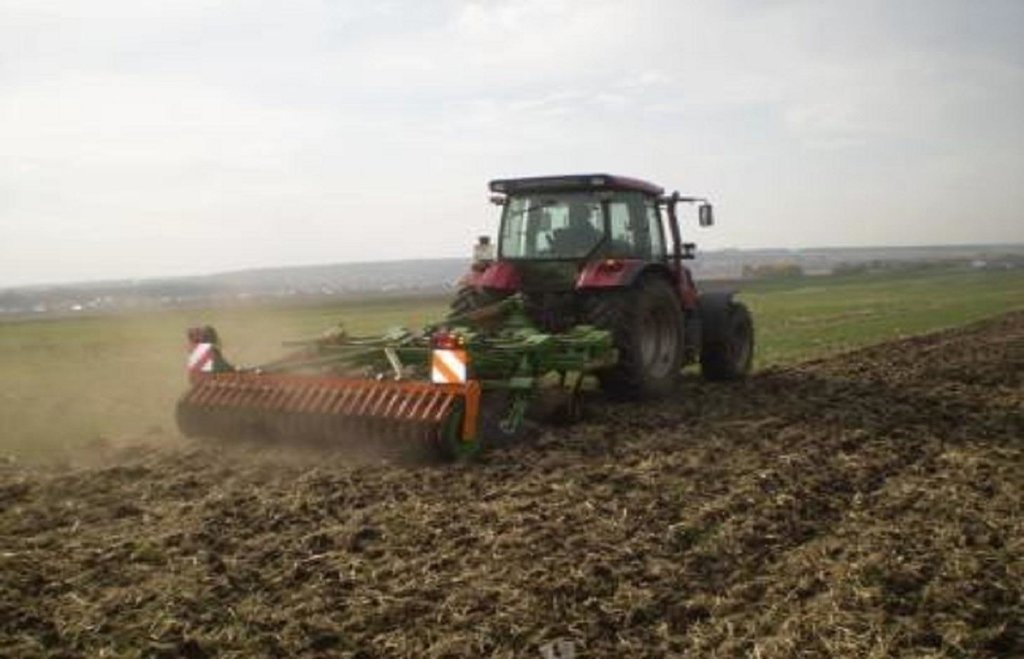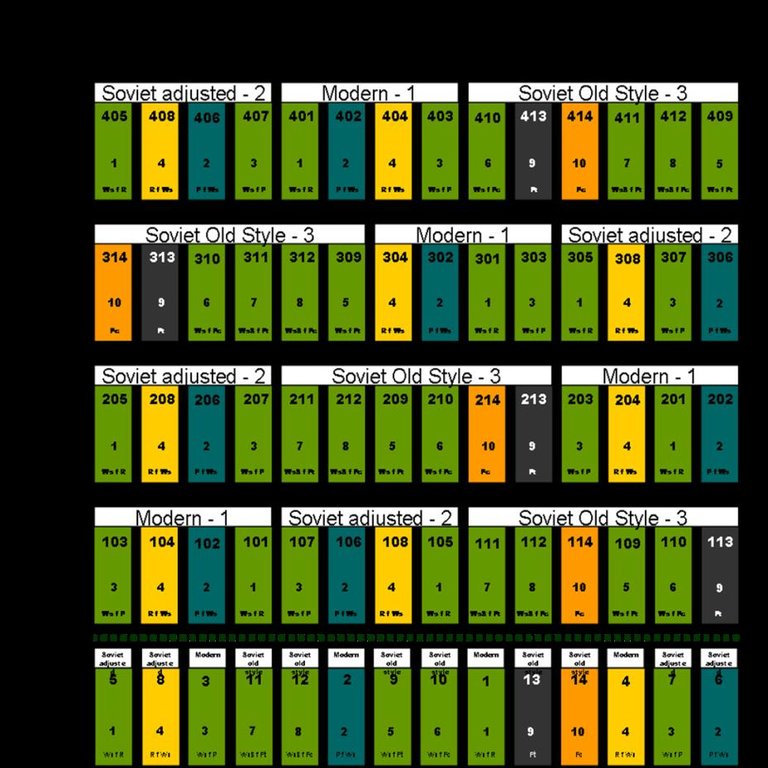Minimum Tillage [俄罗斯联邦]
- 创建:
- 更新:
- 编制者: Peter Liebelt
- 编辑者: –
- 审查者: Deborah Niggli
Минимальная обработка
technologies_1315 - 俄罗斯联邦
查看章节
全部展开 全部收起1. 一般信息
1.2 参与该技术评估和文件编制的资源人员和机构的联系方式
有助于对技术进行记录/评估的项目名称(如相关)
Global Assessment of Land Use Dynamics, Greenhouse Gas Emissions and Ecosystem Services (GLUES)1.3 关于使用通过WOCAT记录的数据的条件
(现场)数据是什么时候汇编的?:
23/06/2016
编制者和关键资源人员接受有关使用通过WOCAT记录数据的条件。:
是
1.4 所述技术的可持续性声明
这里所描述的技术在土地退化方面是否存在问题,导致无法被认为是一种可持续的土地管理技术?:
否
2. SLM技术的说明
2.1 技术简介
技术定义:
Minimum tillage is a one-pass operation combined with sowing, using a classic Russian seeder modified for seedbed preparation and soil mixing. It can include shallow stubble cultivation after harvesting.
2.2 技术的详细说明
说明:
Minimum tillage is a key element of the "adapted Soviet cropping system", which aims at more sustainable land use but based on predominantly local technologies. For successful implementation of minimum tillage, adaption of the whole cropping system is required, including crop rotation. Rotation includes a succession of cereal crops (e.g. spring wheat), legumes (peas), and oil seed crops. Stubble cultivation in autumn is best performed with the "Catros" compact disc harrow for a quick, shallow operation. Seedbed preparation is carried out using a classic Russian seeder modified with wing shares for shallow seedbed preparation including soil mixing. In general, the performance of this drill is very close to that of a cultivator.
Minimizing tillage, saves time and fuel, and also helps to reduce evaporation, as well as protecting the soil against erosion. Shallow tillage with disc harrows after harvest ensures better stubble mixing and stimulates the germination of weed seeds. The adapted seeder, SZS 2.1, works with wing shares that open the soil and place the seed. Thus traditional deep tillage operations for the preparation of the seedbed can are omitted: that helps to reduce costs. With respect to crop protection, the first and most important element is to implement a full crop rotation. To control late germinating weeds and seeds of the previous crop, a disc harrow is used for shallow cultivation – this can be supplemented by the application of a non-selective herbicide if there is germination - to avoid the risk of flowering before the hard frost sets in. Fertilization becomes more important, because of the decreased mineralization rate under minimized soil tillage, especially at the beginning of the conversion of the cropping system.
The Technology including crop rotation was tested in the field in 4 test plots with 4 repetitions at the test site in Poluyamki. Results showed that the intensity of soil tillage and seeding methods used had a great influence on crop establishment and expected yields. It was demonstrated that minimizing tillage leads to higher water use efficiency and highest yields. Positive effects were also observed regarding soil structure and soil fertility already after 3 years. Minimized soil disturbance led to higher aggregate stability, which leads to a lower risk of wind erosion, increased soil organic carbon storage and soil fertility as well as available soil water content. The adapted Soviet system is more profitable, due to higher gross margins.
The test site in Poluyamki is located in the dry steppe of the border region next to Kazakhstan, where, due to the climatic conditions, no natural afforestation occurs, and the planted windbreaks don’t grow vigorously due to the prevailing aridity. The annual precipitation is under 300 mm a year. Probably the greatest climatic influence factor is the precipitation - in terms of quantity and space/ time distribution and, due to high summer temperatures, the high rates of evapotranspiration. The total yearly precipitation rate is the primary yield-limiting factor in all steppe regions. The ratio between precipitation and evaporation is negative. In the late weeks of spring, prolonged droughts must be expected in 5-year cycles, limiting germination and crop establishment. The soils are classed among those of cool-tempered grasslands. Due to their physical and chemical characteristics, these soils (Chernozems and Kastanozems) have high agronomic potential.
2.3 技术照片
2.5 已应用该技术的、本评估所涵盖的国家/地区/地点
国家:
俄罗斯联邦
区域/州/省:
Russian Federation/Altai Krai
有关地点的进一步说明:
Mikhaylovski district (Pavlovski district, Mamontovski district)
注释:
Boundary points of the Technology area: Centre latitude: _52° 4'3.00"N Centre longitude: 79°54'26.16"E Test site Poluyamki
Map
×2.6 实施日期
如果不知道确切的年份,请说明大概的日期:
- 不到10年前(最近)
2.7 技术介绍
详细说明该技术是如何引入的:
- 在实验/研究期间
注释(项目类型等):
Already during the Soviet land use periode temporal,especially after the Virgin land campagne (1954-'63)efforts were made to minimize soil tillage intensity to obtain from conventional ploughing system. An important scientific thinker for this innovative farming systems was T. C. Malcev. But at this time the new approaches for minimized tillage systems were not seriously implemented in Russia. Only in the last decade a significant trend towards minimum soil tillage can be recodnized in the Russian agriculture
3. SLM技术的分类
3.1 该技术的主要目的
- 改良生产
- 减少、预防、恢复土地退化
3.2 应用该技术的当前土地利用类型

农田
- 一年一作
注释:
Major land use problems (compiler’s opinion): The decrease of soil organic carbon content in the soils and loss of topsoil depth has led to a decrease in soil fertility. Additionally, the negative soil water balance due to the high summer temperatures and evaporation, and the high spatial and temporal variability of precipitation, is a serious problem relating to the lack of soil water.
Major land use problems (land users’ perception): The land users who were involved in the studies and implemented the new farming practices have a similar opinion. But there are still a lot of farmers that underestimate the ecological risks of soil degradation resulting from conventional/ traditional soil management.
3.3 有关土地利用的更多信息
该技术所应用土地的供水:
- 雨养
每年的生长季节数:
- 1
具体说明:
Longest growing period in days: 110, Longest growing period from month to month: May-October
3.4 该技术所属的SLM组
- 最小的土壤扰动
3.5 技术传播
具体说明该技术的分布:
- 均匀地分布在一个区域
如果该技术均匀地分布在一个区域上,请注明覆盖的大致区域。:
- 0.1-1 平方千米
注释:
Total area covered by the SLM Technology is 0.13 m2.
The total investigation area of the SLM Technology “Minimum Tillage” refers to the test site areas: 1. Poluyamki, Mikhaylovskiy Rayon: 13ha ; 2. Pervomayskiy, Mamontovskiy Rayon: 10ha and 3. Komsomolskiy, Pavlovskiy Rayon: 3ha all managed by Minimum Tillage. This questionnaire is related to the test site in Poluyamki, Mikhaylovskiy Rayon
3.6 包含该技术的可持续土地管理措施

农艺措施
- A1:植被和土壤覆盖层
- A2:有机质/土壤肥力
- A3:土壤表面处理

管理措施
- M2:改变管理/强度级别
注释:
Type of agronomic measures: better crop cover, mulching, green manure, mineral (inorganic) fertilizers, rotations / fallows, minimum tillage, non-inversion tillage
3.7 该技术强调的主要土地退化类型

土壤水蚀
- Wt:表土流失/地表侵蚀

土壤风蚀
- Et:表土流失
- Ed:风蚀风积
- Eo:场外劣化效应

化学性土壤退化
- Cn:肥力下降和有机质含量下降(非侵蚀所致)

物理性土壤退化
- Pc:压实
注释:
Main causes of degradation: soil management (Conventional (intensive) soil tillage by phloughing), crop management (annual, perennial, tree/shrub) (Bare fallow (without any vegetation cover)), wind storms / dust storms (Strong wind and storm (local name: Sukhovey) from the south-western central-Asiatic semi-desert regions cause a higher risk of wind erosion especially on traditional cropland without plant cover), droughts (The frequently occurring early-summer drought periods are particularly problematic for agricultural production)
Secondary causes of degradation: education, access to knowledge and support services (The linkages between research, education, extension services and end users need to strengthened, for better knowledge creation and transfer. Need for more efficient and qualified advisory service), Capital for investments (Lack of capital for investment in modern adapted agricultural technologies)
3.8 防止、减少或恢复土地退化
具体数量名该技术与土地退化有关的目标:
- 防止土地退化
- 减少土地退化
4. 技术规范、实施活动、投入和成本
4.1 该技术的技术图纸
4.2 技术规范/技术图纸说明
Soviet Seeder SZS 2.1 with wing shares for shallow soil mixing and seed bed preparation.
Location: Poluyamki. Altai Krai
Date: 20.05.2015
Technical knowledge required for field staff / advisors: high
Technical knowledge required for land users: high
Main technical functions: improvement of topsoil structure (compaction), increase in organic matter, increase of infiltration, increase / maintain water stored in soil, sediment retention / trapping, sediment harvesting
Secondary technical functions: control of raindrop splash, control of dispersed runoff: retain / trap, control of dispersed runoff: impede / retard, control of concentrated runoff: retain / trap, control of concentrated runoff: impede / retard, improvement of surface structure (crusting, sealing), improvement of subsoil structure (hardpan), stabilisation of soil (eg by tree roots against land slides), increase in nutrient availability (supply, recycling,…), reduction in wind speed, increase of biomass (quantity)
Better crop cover
Material/ species: Crop rotation without bare fallow
Mulching
Material/ species: stubble cultivation with disc harrow or harrow weeder
Quantity/ density: 1/year
Green manure
Material/ species: pea
Mineral (inorganic) fertilizers
Material/ species: fertilization with calcium ammonium nitrate
Quantity/ density: yearly
Remarks: (100kg/ha (spring wheat and rape), 50kg (pea)
Rotations / fallows
Material/ species: wheat-pea-wheat-raps
Minimum tillage
Material/ species: Catros (disc harrow) and Seeder СЗС2.1 (wing shares)
Remarks: Catros (depth: 10 cm) after harvest (autumn) and Seeder in May)
Non-inversion tillage
Material/ species: Catros (disc harrow) and Seeder СЗС2.1 (wing shares)
Remarks: Catros (depth: 10 cm) after harvest (autumn) and Seeder in May)
4.6 维护/经常性活动
| 活动 | 措施类型 | 时间/频率 | |
|---|---|---|---|
| 1. | Stubble cultivation | 农业学的 | september |
| 2. | Seeding | 农业学的 | late april/early may |
| 3. | Seeding (extension) | 农业学的 | |
| 4. | Pest management | 农业学的 | period of vegetation |
| 5. | Pest management (extension) | 农业学的 | |
| 6. | Harvest | 农业学的 | september |
4.7 维护/经常性活动所需要的费用和投入(每年)
| 对投入进行具体说明 | 单位 | 数量 | 单位成本 | 每项投入的总成本 | 土地使用者承担的成本% | |
|---|---|---|---|---|---|---|
| 劳动力 | labour | ha | 1.0 | 4.34 | 4.34 | 100.0 |
| 设备 | machine use | ha | 1.0 | 37.4 | 37.4 | 100.0 |
| 设备 | fuel | ha | 1.0 | 47.34 | 47.34 | 100.0 |
| 植物材料 | seeds | ha | 1.0 | 25.3 | 25.3 | 100.0 |
| 肥料和杀菌剂 | fertilizer | ha | 1.0 | 30.83 | 30.83 | 100.0 |
| 肥料和杀菌剂 | pesticides | ha | 1.0 | 9.42 | 9.42 | 100.0 |
| 技术维护所需总成本 | 154.63 | |||||
注释:
The costs refers to 1ha land of the test field in Poluyamki.
4.8 影响成本的最重要因素
描述影响成本的最决定性因素:
The highest cost factors of minimum tillage are equipment, fuel, fertilizer and seeds. Compared to the conventional deep ploughing often without fertilizer application, fertilizer and pesticides are the main additional cost factors.
5. 自然和人文环境
5.1 气候
年降雨量
- < 250毫米
- 251-500毫米
- 501-750毫米
- 751-1,000毫米
- 1,001-1,500毫米
- 1,501-2,000毫米
- 2,001-3,000毫米
- 3,001-4,000毫米
- > 4,000毫米
农业气候带
- 半干旱
Thermal climate class: temperate
5.2 地形
平均坡度:
- 水平(0-2%)
- 缓降(3-5%)
- 平缓(6-10%)
- 滚坡(11-15%)
- 崎岖(16-30%)
- 陡峭(31-60%)
- 非常陡峭(>60%)
地形:
- 高原/平原
- 山脊
- 山坡
- 山地斜坡
- 麓坡
- 谷底
垂直分布带:
- 0-100 m a.s.l.
- 101-500 m a.s.l.
- 501-1,000 m a.s.l.
- 1,001-1,500 m a.s.l.
- 1,501-2,000 m a.s.l.
- 2,001-2,500 m a.s.l.
- 2,501-3,000 m a.s.l.
- 3,001-4,000 m a.s.l.
- > 4,000 m a.s.l.
5.3 土壤
平均土层深度:
- 非常浅(0-20厘米)
- 浅(21-50厘米)
- 中等深度(51-80厘米)
- 深(81-120厘米)
- 非常深(> 120厘米)
土壤质地(表土):
- 中粒(壤土、粉土)
表土有机质:
- 中(1-3%)
5.4 水资源可用性和质量
地下水位表:
5-50米
5.6 应用该技术的土地使用者的特征
生产系统的市场定位:
- 商业/市场
非农收入:
- 低于全部收入的10%
相对财富水平:
- 平均水平
- 非常丰富
个人或集体:
- 员工(公司、政府)
机械化水平:
- 机械化/电动
性别:
- 男人
说明土地使用者的其他有关特征:
Land users applying the Technology are mainly Leaders / privileged
There are generally less woman than men in rural regions caused by rural-urban migration. Furthermore, jobs in the agricultural sector are not so attractive for woman.
Population density: 10-50 persons/km2
Annual population growth: negative
5.7 应用该技术的土地使用者拥有或租用的平均土地面积
- < 0.5 公顷
- 0.5-1 公顷
- 1-2 公顷
- 2-5公顷
- 5-15公顷
- 15-50公顷
- 50-100公顷
- 100-500公顷
- 500-1,000公顷
- 1,000-10,000公顷
- > 10,000公顷
这被认为是小规模、中规模还是大规模的(参照当地实际情况)?:
- 大规模的
5.8 土地所有权、土地使用权和水使用权
土地所有权:
- 州
- 个人,未命名
土地使用权:
- 社区(有组织)
- 租赁
用水权:
- 自由进入(无组织)
注释:
state: 45%, the data refer to the Altai Krai
5.9 进入服务和基础设施的通道
健康:
- 贫瘠
- 适度的
- 好
教育:
- 贫瘠
- 适度的
- 好
技术援助:
- 贫瘠
- 适度的
- 好
就业(例如非农):
- 贫瘠
- 适度的
- 好
市场:
- 贫瘠
- 适度的
- 好
能源:
- 贫瘠
- 适度的
- 好
道路和交通:
- 贫瘠
- 适度的
- 好
饮用水和卫生设施:
- 贫瘠
- 适度的
- 好
金融服务:
- 贫瘠
- 适度的
- 好
6. 影响和结论性说明
6.1 该技术的现场影响
社会经济效应
生产
作物生产
注释/具体说明:
In the first years after the change of the cropping system, there is an increased risk of crop losses due not correct/suitable management of the new cropping system
收入和成本
农业投入费用
注释/具体说明:
mainly for initial investments and herbicides in the first years
农业收入
注释/具体说明:
but increase of costs for herbicides and fertilizer; decrease for fuel and labor
其它社会经济效应
Increase use of herbicide applications
注释/具体说明:
particular necessary in the first years after the imlementation of the minimum tillage system
社会文化影响
食品安全/自给自足
注释/具体说明:
In general yes, but food security is not a problem in this region.
冲突缓解
contribution to human well-being
注释/具体说明:
Technology makes a contribution to the long-term productivity of the soil – the most important factors in the rural areas of the Kulunda region. Furthermore, it leads to an increase in efficiency and to an improvement of the economic situation of farms, which might lead to a decrease in out-migration of the youth.
生态影响
水循环/径流
地表径流
蒸发
土壤
土壤水分
土壤覆盖层
土壤流失
土壤压实
养分循环/补给
土壤有机物/地下C
生物多样性:植被、动物
有益物种
减少气候和灾害风险
碳和温室气体的排放
风速
其它生态影响
Increased use of herbicide application
注释/具体说明:
Especially in the first years after the implementation of the minimum tillage system.
6.2 该技术的场外影响已经显现
水资源可用性
注释/具体说明:
there is a higher content of soil moisture under minimum tillage than under traditional ploughing especially in dry weather periods / drought periods.
风力搬运沉积物
对邻近农田的破坏
6.3 技术对渐变气候以及与气候相关的极端情况/灾害的暴露和敏感性(土地使用者认为的极端情况/灾害)
渐变气候
渐变气候
| 季节 | 气候变化/极端天气的类型 | 该技术是如何应对的? | |
|---|---|---|---|
| 年温度 | 增加 | 好 |
气候有关的极端情况(灾害)
气象灾害
| 该技术是如何应对的? | |
|---|---|
| 局地暴雨 | 好 |
| 局地风暴 | 好 |
气候灾害
| 该技术是如何应对的? | |
|---|---|
| 干旱 | 好 |
其他气候相关的后果
其他气候相关的后果
| 该技术是如何应对的? | |
|---|---|
| 缩短生长期 | 不好 |
注释:
The increase of air temperature and wind lead to an increase of the evapotransporation rate and consequently, as well as rainfall decrease and droughts, to a decrease of soil water content that is one of the most important limiting factor in crop production. The minimization of soil tillage intensity helps to reduce the evapotranspiration rate and thus leads to a higher soil water content. The stubble slow down the wind, that protect the soil against erosion and reduce the evapotranspiration rate.
6.4 成本效益分析
技术收益与技术建立成本相比如何(从土地使用者的角度看)?
短期回报:
中性/平衡
长期回报:
积极
技术收益与技术维护成本/经常性成本相比如何(从土地使用者的角度看)?
短期回报:
稍微积极
长期回报:
积极
6.5 技术采用
注释:
100% of land user families have adopted the Technology without any external material support
The 3 farms/ sites where minimum tillage was tested were already interested in conservation technologies and were able to invest in new machinery, which is not representative of the whole Kulunda region. There is a moderate trend towards spontaneous adoption, but this trend depends on different natural and socioeconomic factors, like precipitation or the economic situation and financial power of the farmers.
There is a trend towards spontaneous adoption of the Technology, but this trend depends on different natural and socioeconomic factors like the precipitation or conditions an economic situation of the financial power of the farms. For example the drier the conditions, the more sense is to minimize the tillage. But there is a need to invest in new machinery. An advantage of the tested Adapted Soviet System in contrast to the Modern Soviet System is the less need for new machinery through the use of old Soviet machinery.
6.7 该技术的优点/长处/机会
| 编制者或其他关键资源人员认为的长处/优势/机会 |
|---|
| Increase of soil aggregate stability and improved soil structure thus better erosion control and protection of soil organic matter will improve soil fertility and water holding capacity |
| Minimization of evaporation losses through the mulch layer |
| Protection of soil organisms thus ensuring natural soil forming processes |
| Lower input costs (materials, fuel, labour, time) and quicker field operations. |
| A great advantage of the tested ‘minimum tillage’ in contrast to ‘no till‘ is that the former needs no new machinery because of the use and adaptation of old Soviet machinery. |
6.8 技术的弱点/缺点/风险及其克服方法
| 编制者或其他关键资源人员认为的弱点/缺点/风险 | 如何克服它们? |
|---|---|
| Need for comprehensive system knowledge and risk of significant crop losses in case of incorrect implementation | Knowledge transfer, Capacity building and extension services, State support (subsidies for new technologies) |
| Application of chemical herbicides leads to higher costs and possible ecological risks | Selective spraying using the “Amaspot” system that is based on infrared detection of weeds. |
| Higher requirements for fertilizers, especially at the beginning, due to lower mineralization rates and less nutrient availability compared to conventional cultivation | Higher fertilizer application in the first years after conversion. |
| Challenging straw management that leads to higher risk of fungal infestation and poorer field crop emergence | Good straw management: effective straw chopping and spreading as well as stubble cultivation for an optimal straw/ soil ratio. |
7. 参考和链接
7.1 信息的方法/来源
- 实地考察、实地调查
- 与土地使用者的访谈
链接和模块
全部展开 全部收起链接
无链接
模块
无模块







